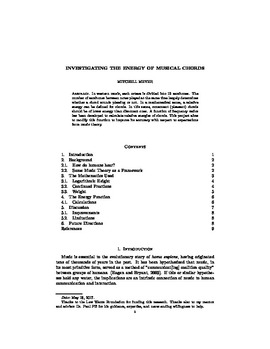| dc.contributor.author | Meyer, Mitchell | |
| dc.date.accessioned | 2019-02-09T14:24:24Z | |
| dc.date.available | 2019-02-09T14:24:24Z | |
| dc.date.issued | 2017-04-25 | |
| dc.identifier | oksd_meyer_HT_2017 | |
| dc.identifier.uri | https://hdl.handle.net/11244/317243 | |
| dc.description.abstract | In western music, each octave is divided into 12 semitones. The number of semitones between notes played at the same time largely determines whether a chord sounds pleasing or not. In a mathematical sense, a relative energy can be defined for chords. In this sense, consonant (pleasant) chords should be of lower energy than dissonant ones. A function of frequency ratios has been developed to calculate relative energies of chords. This project aims to modify this function to improve its accuracy with respect to expectations from music theory. | |
| dc.format | application/pdf | |
| dc.language | en_US | |
| dc.rights | Copyright is held by the author who has granted the Oklahoma State University Library the non-exclusive right to share this material in its institutional repository. Contact Digital Library Services at lib-dls@okstate.edu or 405-744-9161 for the permission policy on the use, reproduction or distribution of this material. | |
| dc.title | Investigating the energy of musical chords | |
| osu.filename | oksd_meyer_HT_2017.pdf | |
| osu.accesstype | Open Access | |
| dc.type.genre | Honors Thesis | |
| dc.type.material | Text | |
| dc.contributor.director | Fili, Paul | |
| dc.contributor.facultyreader | Wright, David | |
| thesis.degree.discipline | Mathematics | |
| thesis.degree.grantor | Oklahoma State University | |
